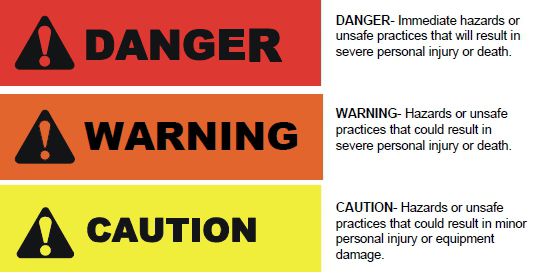Know your OSHA and ANSI safety color codes for all hazards
Dec 18, 2018
Color coding is a brilliant safety idea because workers can tell at a glance - almost without thinking - that they’re facing a hazard and how bad that hazard is. That is why the Occupational Safety and Health Act (OSHA) requires that all industries color-code safety equipment locations, physical hazards and protective equipment. Section 1910.144 and .145 cover signs for various purposes (e.g., danger, caution, safety instruction) and the design and wording of such signs. It also spells out requirements for accident prevention tags and slow-moving vehicle emblems. American National Standards Institute (ANSI) color codes for safety signs are described in ANSI Z535.1-2011. OSHA has also adopted the ANSI Z535.1-2011 standard for use on OSHA compliant signs.
Safety colors
Although red is generally associated with danger in nearly everyone’s mind, the warnings indicated by other colors may not be so obvious to all workers.

An immediately hazardous situation. If the hazardous situation is not avoided, death or serious injury will occur.
OSHA recommends using red, or predominantly red, for danger signs or tags, with lettering or symbols in a contrasting color (usually white against the red background). Red is also used for fire apparatus and equipment, safety containers for flammables, and safety devices such as switches for emergency stopping of machinery, stop bars, and buttons. Additionally, red is used for lights at barricades and obstructions, fire alarm boxes, fire exit signs and sprinkler piping.

A potentially hazardous situation. If the hazardous situation is not avoided, death or serious injury could occur.
These orange, or predominantly orange, signs and tags generally have black lettering or symbols. Orange is often used for potentially dangerous parts of machinery or equipment that may cut, crush, shock, or otherwise injure a person.

A potentially hazardous situation. If the hazardous situation is not avoided, minor or moderate injury could occur.
These signs and tags are all yellow, or predominantly yellow, with lettering or symbols in a contrasting color (usually black). Yellow is often used for physical dangers such as slipping, tripping, falling, striking against, and pinch points. It is also used for construction equipment, handrails, guardrails, material handling equipment, piping systems containing dangerous materials, waste containers, and exposed unguarded edges.

Indicates safety-related instructions, procedures or the locations of safety equipment.
These signs usually have white lettering against the green background. Some part of the sign may also contain black lettering against a white background. Green is used to designate first-aid equipment, emergency eyewash stations, safety bulletin boards, gas masks, stretchers and so forth.

A property-damage-only hazard, no personal injury is possible.
In this category are equipment under repair. Warnings should be located at the starting point or power source of machinery.

This designates radiation hazards. It is often used in combination with yellow on tags, labels, signs, and floor markers.
Other color combinations
Additionally there are other color combinations specified:
Fluorescent Orange/Orange-Red = Biological Hazard.
These signs and tags have lettering or symbols in a contrasting color (usually black). This color designates infectious agents and wastes that pose a risk of death, injury, or illness.
Fluorescent Yellow-Orange triangle with Dark Red border
These signs designate slow moving vehicles.
(Data from OSHA, ANSI, Sherwin-Williams and Ziptape)
Valmet equipment and process signage

When you see this symbol on your Valmet-supplied machine or in a Valmet-supplied manual, be alert to the potential for personal injury.
Valmet manuals also use the alert symbol, with terms such as DANGER, WARNING or CAUTION, to alert you and other mill personnel of actions or conditions that may lead to accidents. Valmet machinery also displays safety signs and tags at appropriate points to show safety risks that may exist.

Be Safe.